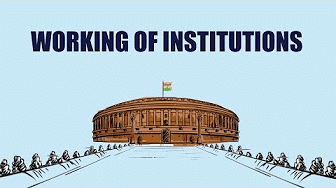Key Concepts - Working of Institutions | Chapter Notes For Class 9 PDF Download
How a Major Policy Decision is Taken?
- Government of India appointed a Commission in 1979, headed by B.P. Mandal, called Second Backward Commission.
- Commission gave a report in 1980. One of the suggestions was to reserve 27 per cent of government jobs for Socially and Economically Backward Classes (SEBC).
- Parliament discussed this for many years.
- Janata Dal won elections in 1989. V.P. Singh, the Prime Minister, decided to implement reservations.
- The President announced it in his address to the Parliament.
- On 6 August 1990, the Cabinet decided to implement and the Prime Minister announced it in both Houses of Parliament.
- The senior officers drafted an order, signed by an officer and it became the Memorandum issued on 13 August 1990.
- There was a heated debate on the issue and it was finally taken to the Supreme Court. The case was known as “Indira Sawhney and others vs Union of India case.”
- In 1992 Supreme Court declared the Mandal order as valid but asked for some modifications.

Need for Political Institutions
- A government has to perform various duties, formulate policies and implement them.
- Some have to formulate schemes, some have to take decisions, some have to implement the decisions.
- Hence the need for institutions to do all the above.
- The Constitution of a country lays down basic rules on powers and functions of each institution.
- The institutions are the Legislative (Parliament), the Executive (the Government) and the Judiciary.
Parliament :
(i) It is needed as final authority to make laws in the country.
(ii) To exercise control over the workings of the government.
(iii) To control the expenditure of the government, and control public money.
(iv) As the highest forum of discussion and debate it decides public issues and national policies.
Two Houses of Parliament. Lok Sabha and Rajya Sabha. The former has elected representatives and is the House of People.
- The Rajya Sabha elected by the elected members of each State Assembly is called the Council of States.
- Lok Sabha is more important in money matters, control over the executive, has more members.
- Rajya Sabha is more important in matters concerning the states.
- Lok Sabha is elected for a period of five years. The Rajya Sabha is a permanent House, with
- one third members retiring every two years. The term of each member is for six years.
Political Executive
- The President, the Prime Minister and his Council of Ministers and the civil servants form the executive.
- The Political Executive consists of political leaders elected by the people, who act on their behalf and are responsible to the public who elected them. They take all the decisions, understand the overall picture.
- The second category is called the permanent executive consisting of civil servants. They help the political executive in carrying out the day to day work. They are experts but do not take the final decision.
- Prime Minister has three kind of ministers to help him : (i) Cabinet Ministers, (ii) Ministers of State and (iii) Deputy Ministers.
- The Prime Minister’s position is supreme. He chooses his Cabinet and his decision is final, except in a coalition government where he has to listen to other party members.
- When the Prime Minister quits, the entire ministry quits.
- The President is the nominal head in India. He is not directly elected by the people as in USA.
- All the Members of Parliament and Members of the State Legislatures elect him. Since he is elected indirectly, he does not have the same powers as the Prime Minister.
- The President exercises all his legislative, executive, financial, judicial, military powers only on the advice of the Prime Minister and his Council of Ministers.
- The President can only delay a bill. If the Parliament passes it again, he has to sign it.
- President has the power to appoint the leaders when there is a coalition on his own discretion.
The Judiciary : India has one of the most powerful judiciaries.
- The Judiciary is independent of both the Executive and the Legislature.
- The Chief Justice of the Supreme Court is appointed by the President on the advice of the Prime Minister and his Council of Ministers.
- The other judges of the Supreme Court and the State High Courts are appointed in the same way but on the advice of the Chief Justice.
- Once appointed, the Judges can be removed only by impeachment.
- The Judiciary is the custodian of the Constitution, and the Supreme Court and the High Courts have the power to interpret the Constitution.
- It can declare any law passed by the Legislature as invalid, if it violates the Constitution.
- It safeguards the Fundamental Rights of the people of India, and checks malpractices and misuse of power by the Executive or the Legislature.
FAQs on Key Concepts - Working of Institutions - Chapter Notes For Class 9
| 1. What are institutions? |  |
| 2. How do institutions work? |  |
| 3. What is the role of institutions in society? |  |
| 4. How do institutions impact individuals? |  |
| 5. How can institutions be reformed? |  |






















